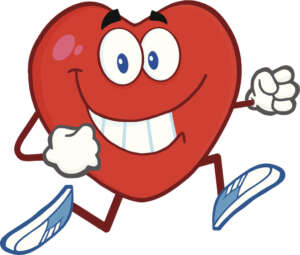
February is marked by Valentine’s Day and Heart Health Month in the U.S. So it’s the perfect time to cozy up to how East Asian Medicine views the functions of the heart and how we can keep it working optimally.
In East Asian Medicine (EAM), the heart is more than just a physical organ responsible for pumping blood. It holds a profound and multifaceted role in the body, encompassing both its physiological functions and its connection to the emotional and spiritual realms. Often referred to as the “Emperor” of the organs, the heart in EAM is a central player in the opera of health and wellness.
In EAM, each organ has its own unique properties and functions, and the heart is no exception. Physiologically, the heart has three main functions. But there are also other aspects to consider, the emotional aspect and the psychological aspect.
The three main physiological functions of the heart are as follows:
1. Govern Blood Circulation – The heart’s primary role is to pump blood throughout the body. In EAM, it is considered the “ruler” of the blood, ensuring that it circulates smoothly to nourish the tissues and organs.
2. Regulate Sweat – The heart’s influence extends to the body’s sweat glands. Excessive sweating or the lack of sweating can be indicative of heart imbalances.
3. House the Shen (Spirit) – The heart is said to house the Shen, which represents consciousness, emotions and the mind. A balanced heart leads to a calm mind, sound sleep, and clear thinking. The Shen is similar to conciousness. During the day, the Shen goes out and interacts with the world and when we sleep at night, it is because the Shen is “sleeping” in the heart. So whenever a person is having difficulty falling asleep or is prone to excessive dreaming, a pathology of the heart may be to blame.
Emotionally, the heart is associated with joy and happiness. However, when the heart is out of balance, this joy can turn into excessive excitement or overstimulation, leading to restlessness, anxiety or even mania. Conversely, an imbalance in the heart can manifest as sadness or depression when joy is deficient.
Psychologically, the heart and the mind are inseparable and each plays a role in the functioning of the other. A harmonious heart leads to a calm and clear mind, while emotional disturbances can disrupt the heart’s balance. It’s not uncommon for EAM practitioners to consider emotional well-being when addressing heart-related issues.
The heart is said to govern all emotions and there are 5 main organs from an EAM perspective. Each organ corresponds with a unique emotion, however, it is the heart itself that processes all emotions of the other organs. Whenever we are in a state of chaos or feel completely overwhelmed (with stress, grief, fear, etc.), it is our heart qi that suffers the most. This is when people really begin to feel scattered and are unable to figure out what’s wrong or the source of the problem. As an acupuncturist, it is my job to strengthen the qi of the heart and calm the shen with needles and herbs. This way, the heart and Shen are able to process and sort out these emotions. This is similar to the idea of taking vitamins or supplements when the body is deficient in certain nutrients.
Acupuncture and herbal formulas are just a couple of ways to nourish and maintain a healthy heart. And here are a few other ways:
1. Balance Your Emotions – Finding emotional balance and cultivating joy in your life is something that comes with time, age and practice. Try engaging in activities that make your heart sing, whether it’s spending time with loved ones, pursuing hobbies or practicing mindfulness.
2. Be Physically Active – Regular exercise, particularly gentle forms like Tai Chi or Qi Gong, can help balance heart energy and improve overall cardiovascular health.
3. Get Adequate Sleep – Sufficient restful sleep is crucial for heart health. Work on establishing a regular sleep schedule and create a calming bedtime routine that helps you relax.
4. Eat A Heart Healthy Diet – In EAM, bitter foods like dark chocolate and bitter melon are believed to support the heart. Additionally, foods rich in omega-3 fatty acids, like flax seeds and chia seeds, can benefit the heart.
5. Manage Your Stress – Chronic stress can strain the heart. Explore stress-reduction techniques like meditation, deep breathing exercises or spending time in nature to help reduce cortisol levels that contribute to feelings of stress and anxiety.
Because your heart is so intimately linked to your vitality, if your heart energy is low you may get symptoms such as a vague sadness that doesn’t seem to have a cause, difficulty concentrating or poor memory, a feeling of a lack of purpose or direction, anxiety, chronic restlessness, and of course, heart symptoms such as palpitations or an irregular heartbeat.
In EAM, the heart is paired with the pericardium. The pericardium is the connective tissue that surrounds your heart, protecting it from infection and physical shock. But your pericardium also tries to protect you from emotional shock, grief or trauma. If you have ever suffered from a broken heart, then your pericardium will energetically put up protective walls to prevent you from further pain. This can be a great strategy at the time, but in the long run, it can prevent you from fully giving and receiving love to and from others, as well as to and from yourself. The drawbridge that stops more pain from coming in also prevents love from entering and leaving. The fear of being hurt again can mean we lose a meaningful connection to others and ourselves, which is not so good for our hearts.
Understanding the connection between the heart and the emotions can make navigating those emotions less cumbersome. And by incorporating the aforementioned practices, anyone can work towards maintaining a healthy heart and balanced emotions.

